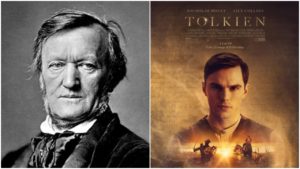
Opera Meets Film: How ‘Das Rheingold’ Inspires ‘Tolkien’ To New Emotional & Narrative Heights
By David Salazar“Opera Meets Film” is a feature dedicated to exploring the way that opera has been employed in cinema. We will select a section or a film in its entirety, highlighting the impact that utilizing the operatic form or sections from an opera can alter our perception of a film that we are viewing. This week’s installment features “Tolkien.”
Tolkien’s “Lord of the Rings” is undeniably one of the most iconic stories of all time and it is no surprise that it is often cited in the context with opera’s, “Der Ring des Nibelungen.” Many compare Wagner’s own quest for a powerful ring with Tolkien’s, despite the fact that the two legendary creators approach their respective stories from different angles.
So it is inevitable that at some point in a biopic about the creator of Hobbits, that Wagner’s own world of Nibelungs would show up. And it proves to be one of the major highlights of the entire film.
As noted by IndieWire critic David Ehrlich, “That trip to the opera is the film’s strongest passage. More than any other sequence, it has a self-contained soul of its own; a rare and refreshing change of pace…”
And change of pace it is, for the film’s opera scene, which features “Das Rheingold,” represents not only a change of style and emotion for the main character, but a major change of direction for him.
Wagner is hinted at earlier in the film by Edith Bratt, who Tolkien is in love with. After some lovers’ quarrels between the two (over some flirtation over a conversation about Wagner), Tolkien takes Edith to the opera to see “Das Rheingold.” They don’t manage to get a ticket to the show so they sneak backstage and put on the opera for themselves.
With the opening of Wagner’s tetralogy underway, this scene is portrayed as the climax of Edith and Tolkien’s relationship at this stage in their lives, with the end of the montage joining them in a furtive kiss.
The scene’s romanticism is fleshed out by shifting music from “Das Rheingold,” emphasizing the passing of time throughout the montage. What’s more, the entire scene is about more than just joining two lovers, but about joining them through creativity. Both are portrayed as artists (Edith is a pianist), but they are stuck in their respective positions with their art. Judith is forced to play mediocre music for her guardian while Tolkien hasn’t quite developed his voice. So in this scene, with the inspiration of Wagner, we see them acting out scenes from their own imagination and actually expressing themselves fully (You could even argue that the filmmakers themselves found inspiration with the camera breaking from a standard pattern of close-ups and wide shots to a Steadicam that swoops around the actors and even dollies away from them at the very end). Wagner’s music, often remarked as the embodiment of the will itself, almost wills the two lovers to finally reveal and enjoy their passion for art and one another. Love’s union seems only inevitable in a story largely about the value of love over power.
But Wagner’s “Rheingold” sequence actually transforms the film in a different way as well – it almost kickstarts the film’s story about Tolkien coming to terms with his identity as a writer. While it comes at the midpoint of the film, to this point Tolkien has been a rather passive character going with the flow of his world. After this scene and this moment of artistic revelation leads into an extensive section about Tolkien grappling with this very conflict in his own being. Much like “Rheingold” initiates the “Ring’s” journey for three more operas, in this film, it becomes the start of Tolkien’s quest for his artistic identity, which he will eventually find at the close with his very famous story about a Ring.


